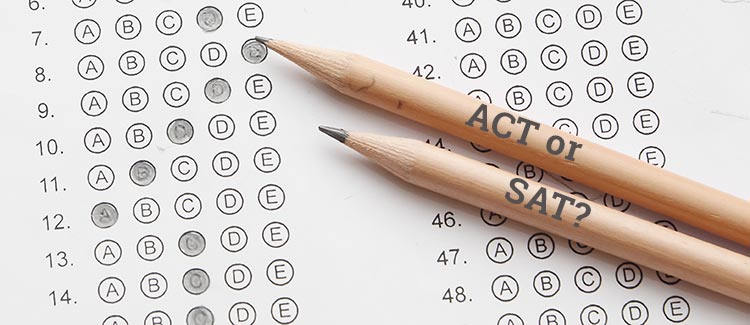The ACT and the SAT are national standardized tests. Many colleges and universities require students to take one of these tests as part of the college admissions process.
Key differences between the ACT and SAT
The two tests are similar in many ways: both are reading-intensive, cover algebra I and II, geometry, and trigonometry, and include an optional writing section that many colleges require.
The most notable differences between the tests are rooted in students’ test-taking strengths and weaknesses. The SAT allows more time per question than the ACT; however, SAT questions are often less straightforward than those on the ACT. The ACT has a science section dedicated to critical thinking skills, while the SAT’s math section includes a segment on data analysis. Students who take the ACT may use a calculator for all math problems, while students who take the SAT may only use a calculator for some math problems.
After the SAT was overhauled in 2016, some key differences between the two tests disappeared. In the past, SAT test-takers lost points for wrong answers, but that’s no longer the case. And the new SAT doesn’t have the notoriously challenging vocabulary section that was on the old test.
Do college admissions officers prefer the ACT or SAT?
Most colleges accept both the SAT and the ACT, and college admissions officers have no preference for which test your child takes. This flexibility means that your teen can choose the test they’re most comfortable taking and on which they earn the best scores. To see whether a college accepts both tests, check the application requirements listed on the school’s website or call the school’s admissions office.
Not every college requires standardized tests. A growing number of schools make these tests optional, which means students don’t need to submit SAT or ACT scores at all. Other schools are test-flexible, which means that students can submit alternatives to the SAT or ACT for consideration during the admissions process. Check out the full list of the more than 300 test-flexible and test-optional colleges on FairTest.org.
Which test is the right fit?
Since the SAT and ACT require different strategies, the “right” test to take depends on your student’s personal strengths. It’s best to get a taste for each test through practice exams and test preparation, which will help your child learn which test he or she is more comfortable taking and scores better on.
Thanks to many online resources, test prep can start at home and will help your student learn which test is a better fit. Free online practice is available for both tests.
Where can I find free test prep?
The College Board, which provides the SAT, has partnered with Khan Academy to offer free personalized SAT test prep online. Your child can use Khan Academy to create a personalized SAT study plan complete with video lessons, practice questions, and full-length SAT practice tests. Students can also download an app to their smartphones or tablets that helps them practice for the SAT a little bit each day.
ACT offers a free study guide, and students can access free sample questions on its website by creating an ACT profile or by reviewing free questions and content descriptions for each ACT section: English, math, reading, science, and writing. Students can also purchase ACT’s online test prep program and test prep books.
More free online practice — including ACT and SAT practice tests — is available through Kaplan Test Prep.
Many schools and local libraries offer free ACT or SAT preparation as well. Be sure to check with your school district, school, and local library to see if there are free ACT or SAT preparation classes or practice tests offered in your community.
The PSAT and PreACT
Before they take these high-stakes tests, students can opt to take the PSAT and PreACT — official prep tests for the SAT and ACT — to simulate SAT and ACT testing experiences and help predict potential scores.
The PSAT is the most well-known of the two tests, and many schools offer it in 10th and 11th grade. Students who take the PSAT in 11th grade and score well may qualify for scholarships, including the highly competitive National Merit award. After taking the PSAT, students can access a score report that helps predict their SAT score potential and can be linked to a Khan Academy account to help students study strategically.
The PreACT is a newer option, and is offered by schools between Sept. 1 and June 1 each year. In addition to providing students with a prediction of their ACT score potential, the PreACT offers access to the ACT Interest Inventory, which helps students explore college majors and career options based on their interests. Right now, students can only take the PreACT if it is offered by their schools, but Ed Colby, ACT’s senior director of media and public relations, says an alternative option is coming soon.
Is financial aid available for these tests?
Fee waivers for the SAT, ACT, and PSAT are available for students with financial need. (Read more about taking the SAT or ACT on a budget.) Students who qualify for SAT fee waivers can take the test twice; they also get to choose four colleges where they may apply for free (see the list of more than 2,000 participating colleges). ACT allows students to qualify for up to two fee waivers on a first-come, first-serve basis. ACT fee waivers allow students to send their scores to four colleges for free and to access free online ACT prep through Kaplan.
A growing number of states now provide the ACT or SAT for free, either as an option or as a graduation requirement. Many schools provide the PSAT and PreACT for free, as well.
Should students take both tests?
If money is not an issue, and the colleges on your student’s list accept either test, he or she may want to consider taking both. If your budget is tight or you’re concerned about test burnout, it’s best to take free practice tests for both and then decide which test produces the best results. Students with financial need should also check to see if they qualify for fee waivers.
Do test prep services help raise scores?
There’s some evidence that students can raise their SAT scores using the free online test prep materials on Khan Academy. Most experts say that targeted study programs that focus on the individual teen’s weaknesses on the test can be very helpful, whether they’re using free materials or a paid tutor.
Both the College Board and ACT advise against hiring tutors or paying for expensive prep classes. However, Kaplan and Princeton Review, two test prep services, offer money-back guarantees if your child’s score doesn’t increase after taking their classes. Neither Kaplan nor Princeton Review guarantee that students’ scores will increase by a certain number of points, though.
How many times should students take these tests?
Students can take the SAT and the ACT as many times as they would like. Both tests are offered seven times a year in most states. To see test dates and registration deadlines, check the SAT and ACT calendars. Many students take the tests twice (read more about why your teen should retake the SAT or ACT) in an effort to improve their scores, once as juniors and once as seniors. Both ACT and the College Board allow students to choose which scores they send to colleges. Counselors sometimes caution against taking either test more than three times because the repetitive pressure can cause burnout and stress. Test scores are, after all, just one part of what admissions officers consider during their holistic review of college applications.
Most college admissions officers say they only look at students’ best scores. Some interpret this as the best overall score a student gets in one test-taking session. Others will look at students’ best scores in each category, even if they come from different test sessions.
How can elementary and middle school students get on the right track to succeed on these tests?
There are several things younger students can do to be ready for these tests.
- First and foremost, read. Both tests require strong reading comprehension and vocabulary skills. The best way to prepare is to read a variety of materials — books, magazines, and newspapers — in addition to texts that are required for school classes.
- Take challenging courses. Students who take rigorous courses are more likely to score high on these tests.
- Learn test-taking strategies. It’s important to have subject-matter knowledge, strong reading comprehension, and problem-solving skills, but it’s also important to know how to take tests. Test-taking strategies include knowing how to make a best guess without being sure of the answer, how to pace yourself so there is time to answer all of the questions, and how to read closely to avoid making careless mistakes. Taking practice tests is a great way to practice these skills and to become accustomed to what it’s like to sit, focus, and complete long tests.






